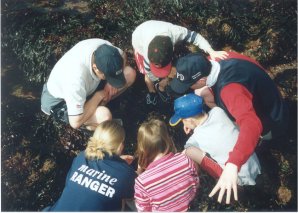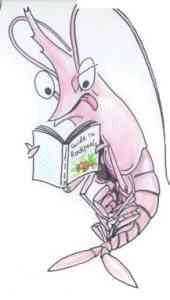|
Exploring the local
rockpools with marine rangers.
-
Learn:
-
How to use the seashore
code of conduct
-
Where to find animals
-
How to treat the animals
handling etc
-
Why it is important to
respect the environment
-
What happens to the
creatures when no respect is given
-
who eats who
-
who turns into who
-
who is related
-
and other strange facts
about the creatures
 An introductory session
to life in the rockpools. After a safety talk the children are separated into
small groups, each with their own ranger, and encouraged to explore the rockpools for the weird and wonderful plants and creatures that live there. The
level of information is adjusted to the group age and capabilities. Relevant
subjects that the children have previously covered (i.e. food chains,
adaptations) can be incorporated into the activity if the ranger is informed
before hand. An introductory session
to life in the rockpools. After a safety talk the children are separated into
small groups, each with their own ranger, and encouraged to explore the rockpools for the weird and wonderful plants and creatures that live there. The
level of information is adjusted to the group age and capabilities. Relevant
subjects that the children have previously covered (i.e. food chains,
adaptations) can be incorporated into the activity if the ranger is informed
before hand.
The activity involves a
close-up look at life in the rock pools and where creatures live on the rocky
shore. The children are all shown some creatures which they may come across and
then in small groups (with a ranger) they explore the rock pools for themselves.
The activity can be adapted to suit certain requirements, e.g. if the class is
studying food chains / adaptations these can be made the focus of the activity.
 Aims of activity Aims of activity
 To
learn how to use the Seashore code of conduct. To
learn how to use the Seashore code of conduct.
 To
find animals in the intertidal zone and learn how to treat them. To
find animals in the intertidal zone and learn how to treat them.
 To
identify and examine local plants and animals in the intertidal zone. To
identify and examine local plants and animals in the intertidal zone.
 To
understand the requirements to sustain life in these areas. To
understand the requirements to sustain life in these areas.
 To
think about the food chains and life cycles within the rocky shore- who eats
who and who turns into who. To
think about the food chains and life cycles within the rocky shore- who eats
who and who turns into who.
 To
examine zonation and adaptations of plants and animals to increase survival
chances To
examine zonation and adaptations of plants and animals to increase survival
chances
 To
appreciate the influence of tidal change- environmental factors that affect
life on the rocky shore. To
appreciate the influence of tidal change- environmental factors that affect
life on the rocky shore.
Relevant parts of the
National Curriculum.
SCIENCE
Primary
-
Unit 2B: Plants and
animals in the local environment.
-
Treat
animals with care and sensitivity
-
Living
things need protection
-
Adaptations of animals that live in different habitats
-
Different kinds of animals in immediate environment
-
Animals
/ Plants in local habitat are interdependent
-
Unit 2C: Variation.
-
Unit 3B: Helping
plants grow well.
-
Plant
growth is affected by temperature.
-
Plants
need light for healthy growth.
-
Plants
provide food for animals (and us). They form the base of food chains.
-
Unit 4B: Habitats.
-
Unit 5B: Life cycles.
-
Unit
6A: Interdependence and Adaptation.
-
How
animals and plants in a local habitat are suited to their environment.
-
That
animals and plants in a local environment are interdependent.
-
Different animals/plants found in different habitats, why they are different.
-
Food
chains in a particular habitat.
Secondary
-
Unit 7C: Environment
and feeding relationships.
-
Interactions with the environment and each other
-
Adaptations for feeding and particular food sources (N/B sea hares are
different colours to suit the different algae they feed on. Limpets always
return to same spot when tide retreats etc)
-
Relate
activity of plant / animals to environmental changes (Daily or seasonal)
-
Climatic Stress
Contributions of different organisms to the community
-
Organisms linked in habitats = food chains – food webs +transfer of energy
-
Different habitats / different features / adaptations
-
Unit 7D: Variation and
Classification.
-
Individual members of a species may differ in many ways, but will have
features in common.
-
Although individuals are like their parents they are not identical.
-
How
environmental differences can result in variations in a species.
-
How to
make sure they are working safely with living organisms.
-
To
start and classify animals into main taxanomic groups.
-
Unit 8D: Ecological
Relationships.
-
Orgainisms only survive where they ahve all the essentials for life and
reproduction.
-
To use
scientific knowledge and understanding to raise questions about habitats.
-
Observe
organisms which commprise the lliving community in a habitat.
-
To work
safely with living things.
-
To show
sensitivity to living things in their environment.
-
That
habitats support differnt living things.
-
Different habitats have different environmental features.
-
Organisms show adaptations to environmental conditions.
-
Both
plants and animals adapt to ensure survival of the species.
-
Abundance / Distribution of organisms in a habitat is affected by
environmental factors (light, water, nutrients)
-
Size of
populations depends on resources (hence more in summer)
-
Apply
their knowledge of populations and habitats to environmental issues like the
protection of living things.
-
Unit 9A: Inheritance
and selection.
-
Characteristics are inherited and how this is used in selective breeding.
-
Why
selective breeding is important.
-
Identify reasons for variations between individuals.
-
Variations arising form environmental differences occur plants.
-
Unit 9D: Plants for
Food.
|